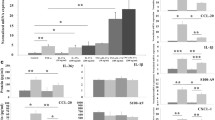Abstract
The influence of the immunosuppressants, cyclosporin A (CsA) and FK506, on cAMP formation was studied in T cells from healthy controls and patients with psoriasis. While basal cAMP levels were not affected, CsA (1 μM) and FK506 (2 nM) prevented the isoprenaline (0.1 μM)-induced increase in cAMP formation. Half-maximal inhibition by FK506 and CsA was observed at about 0.2 nM and 20 nM, respectively. In addition, both agents significantly reduced (by about 50%) the forskolin (8 μM)-stimulated cAMP formation. No differences were noted in CAMP responses (basal, stimulation by isoprenaline, inhibition by CsA and FK506) of T cells from healthy controls and psoriatic patients. We conclude that CsA and FK506 potently and efficiently interfere with the stimulatory adenylyl cyclase pathway in T cells and that regulation of T cell CAMP formation is apparently not altered in psoriasis.
Similar content being viewed by others
References
Baker BS, Fry L (1992) The immunology of psoriasis. Br J Dermatol 126:1–9
de Boer OJ, van der Loos CM, Hamerlinck F, Bus JD, Das PK (1994) Reappraisal of in situ immunophenotypic analysis of psoriasis skin: interaction of activated HLA-DR+ immunocompetent cells and endothelial cells is a major feature of psoriatic lesions. Arch Dermatol Res 286:87–96
Bøyum A (1968) Isolation of mononuclear cells and granulocytes from human blood. Scand J Clin Lab Invest 21 [Suppl]:77–89
Cameron AM, Steiner JP, Sabatini DM, Kaplin AI, Walensky LD, Snyder SH (1995a) Immunophilin FK506 binding protein associated with inositol 1,4,5-trisphosphate receptor modulates calcium flux. Proc Natl Acad Sci USA 92:1784–1788
Cameron AM, Steiner JP, Roskams AJ, Ali SM, Ronnett GV, Snyder SH (1995b) Calcineurin associated with the inositol 1,4,5-trisphosphate receptor-FKBP12 complex modulates Ca2+ flux. Cell 83:463–472
Duncan JI (1994) Differential inhibition of cutaneous T-cell-mediated reactions and epidermal cell proliferation by cyclosporin A, FK506, and rapamycin. J Invest Dermatol 102:84–88
Eedy DJ, Canavan JP, Shaw C, Trimble ER (1990) Beta-adrenergic stimulation of CAMP is defective in cultured dermal fibroblasts of psoriatic subjects. Br J Dermatol 122:477–483
Erlanger BF (1992) Do we know the site of action of cyclosporin? Immunol Today 13:487–489
Green H (1978) Cyclic AMP in relation to proliferation of the epidermal cell: a new view. Cell 15:801–811
Jayaraman T, Brillantes AM, Timerman AP, Fleischer S, Erdjument-Bromage H, Tempst P, Marks AR (1992) FK506 binding protein associated with the calcium release channel (ryanodine receptor). J Biol Chem 267:9474–9477
Liu J (1993) FK506 and cyclosporin, molecular probes for studying intracellular signal transduction. Immunol Today 14:290–295
Ockenfels HM, Nußbaum G, Oeljeklaus P, Schultewolter T, Haen E, Burger PM, Goos M (1994) Drugs that provoke psoriasis vulgaris and those used in its therapy alter the phosphotyrosine content and also the cAMP level of T-cells. Arch Dermatol Res 286:179–180
Powles AV, Baker BS, Fry L (1989) Cyclosporin and skin disease. In: Thomson AW (ed) Cyclosporin: mode of action and clinical application. Kluwer Academic Publishers, Dordrecht, pp 191–212
Schreiber SL, Crabtree GR (1992) The mechanisms of action of cyclosporin A and FK506. Immunol Today 13:136–142
Sugiyama H, Chen P, Hunter M, Taffs R, Sitkovsky M (1992) The dual role of the cAMP-dependent protein kinase Cα subunit in T-cell receptor-triggered T-lymphocytes effector functions. J Biol Chem 267:25256–25263
Voorhees JJ, Duell EA, Stawiski M, Harrell ER (1974) Cyclic nucleotide metabolism in normal and proliferating epidermis. Adv Cycl Nucl Res 4:117–162
Walsh CT, Zydowsky LD, McKeon FD (1992) Cyclosporin A, the cyclophilin class of peptidylprolyl isomerases, and blockade of T cell signal transduction. J Biol Chem 267:13115–13118
Won Y-H, Sander DN, McKenzie RC (1994) Cyclosporin A inhibits keratinocyte cytokine gene expression. Br J Dermatol 130:312–319
Author information
Authors and Affiliations
Rights and permissions
About this article
Cite this article
Ockenfels, H.M., Wagner, S.N., Oeljeklaus, P. et al. Inhibition of T cell cAMP formation by cyclosporin A and FK506. Naunyn-Schmiedeberg's Arch Pharmacol 353, 513–516 (1996). https://doi.org/10.1007/BF00169170
Received:
Accepted:
Issue Date:
DOI: https://doi.org/10.1007/BF00169170




